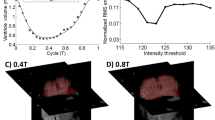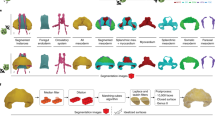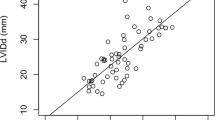Abstract
Through cardiac looping during embryonic development1, paths of flow through the mature heart have direction changes and asymmetries whose topology and functional significance remain relatively unexplored. Here we show, using magnetic resonance velocity mapping2,3,4,5, the asymmetric redirection of streaming blood in atrial and ventricular cavities of the adult human heart, with sinuous, chirally asymmetric paths of flow through the whole. On the basis of mapped flow fields and drawings that illustrate spatial relations between flow paths, we propose that asymmetries and curvatures of the looped heart have potential fluidic and dynamic advantages. Patterns of atrial filling seem to be asymmetric in a manner that allows the momentum of inflowing streams to be redirected towards atrio-ventricular valves, and the change in direction at ventricular level is such that recoil away from ejected blood is in a direction that can enhance rather than inhibit ventriculo-atrial coupling6. Chiral asymmetry might help to minimize dissipative interaction between entering, recirculating and outflowing streams7. These factors might combine to allow a reciprocating, sling-like, ‘morphodynamic’ mode of action to come into effect when heart rate and output increase during exercise6.
This is a preview of subscription content, access via your institution
Access options
Subscribe to this journal
Receive 51 print issues and online access
$199.00 per year
only $3.90 per issue
Buy this article
- Purchase on Springer Link
- Instant access to full article PDF
Prices may be subject to local taxes which are calculated during checkout



Similar content being viewed by others
References
Icardo,J. M. Development biology of the vertebrate heart. J. Exp. Zool. 275, 144–161 (1996).
Firmin,D. N. et al. In vivo validation of MR velocity imaging. J. Comput. Assist. Tomogr. 11, 751– 756 (1987).
Firmin,D. N., Nayler,G. L., Kilner,P. J. & Longmore,D. B. The application of phase shifts in NMR for flow measurement. Magn. Reson. Med. 14, 230–241 (1990).
Kilner,P. J., Yang,G. Z., Mohiaddin,R. H., Firmin,D. N. & Longmore,D. B. Helical and retrograde secondary flow patterns in the aortic arch studied by three-directional magnetic resonance velocity mapping. Circulation 88, 2235– 2247 (1993).
Yang,G. Z., Kilner,P. J., Mohiaddin,R. H. & Firmin,D. N. Transient streamlines: texture synthesis for in vivo flow visualisation. Int. J. Cardiac Imag. (in the press).
Kilner,P. J., Henein,M. Y. & Gibson, D. G. Our tortuous heart in dynamic mode—an echocardiographic study of mitral flow and movement in exercising subjects. Heart Vessels 12, 103–110 ( 1997).
Caro,C. G. et al. Non-planar curvature and branching of arteries and non-planar-type flow. Proc. R. Soc. Lond. A 452, 185– 197 (1996).
Bellhouse,B. J. & Bellhouse,F. H. Fluid mechanics of the mitral valve. Nature 224, 615– 616 (1969).
Peskin,C. S. & McQueen,D. M. in Case Studies in Mathematical Modelling—Ecology, Physiology, and Cell Biology (eds Othmer, H. G., Adler, F. R., Lewis, M. A. & Dallon, J. C.) 309– 337 (Prentice-Hall, Eaglewood Cliffs, NJ, 1996).
Taylor,T. W. & Yamaguchi,T. Flow patterns in three-dimensional left ventricular systolic and diastolic flows determined from computational fluid dynamics. Biorheology 32, 61– 71 (1995).
Taylor,D. E. & Wade,J. D. Pattern of blood flow within the heart: a stable system. Cardiovasc. Res. 7, 14–21 (1973).
Kim,W. Y. et al. Left ventricular blood flow patterns in normal subjects: a quantitative analysis by three-dimensional magnetic resonance velocity mapping. J. Am. Coll. Cardiol. 26, 224–238 (1995).
Ryan,A. K. et al. Pitx2 determines left–right asymmetry of internal organs in vertebrates. Nature 394, 545– 551 (1998).
Logan,M., Pagan-Westphal,S. M., Smith, D. M., Paganessi,L. & Tabin,C. J. The transcription factor Pitx2mediates situs-specific morphogenesis in response to left–right asymmetric signals. Cell 94, 307– 317 (1998).
Noble,M. I. The Frank–Starling curve. Clin. Sci. Mol. Med. 54, 1–7 (1978).
Landesberg,A. Molecular control of myocardial mechanics and energetics: the chemo-mechanical conversion. Adv. Exp. Med. Biol. 430, 75 –87 (1997).
Liang,Y. L. et al. Effects of heart rate on arterial compliance in men. Clin. Exp. Pharmacol. Physiol. 26, 342– 346 (1999).
Di Bello,V. et al. Left ventricular function during exercise in athletes and in sedentary men. Med. Sci. Sports Exercise 28, 190–196 (1996).
Shapiro,L. M. The morphologic consequences of systemic training. Cardiol. Clinics. 15, 373–379 ( 1997).
Yacoub,M. H., Kilner,P. J., Birks,E. J. & Misfeld,M. The aortic outflow and root—a tale of dynamism and crosstalk. Ann. Thorac. Surg. 68, 37–43 (1999).
Friedman,M. H., Brinkman,A. M., Qin,J. J. & Seed,W. A. Relation between coronary artery geometry and the distribution of early sudanophilic lesions. Atherosclerosis 98, 193– 199 (1993).
Kilner,P. J. Morphodynamics of Flow Through the Heart. Thesis, Univ. London (1998).
Acknowledgements
This work was supported by grants from the British Heart Foundation and CORDA, and by a HEFCE JREI award.
Author information
Authors and Affiliations
Corresponding author
Rights and permissions
About this article
Cite this article
Kilner, P., Yang, GZ., Wilkes, A. et al. Asymmetric redirection of flow through the heart. Nature 404, 759–761 (2000). https://doi.org/10.1038/35008075
Received:
Accepted:
Issue Date:
DOI: https://doi.org/10.1038/35008075
This article is cited by
-
An Anatomically Shaped Mitral Valve for Hemodynamic Testing
Cardiovascular Engineering and Technology (2024)
-
A comprehensive mathematical model for cardiac perfusion
Scientific Reports (2023)
-
Toroidal vortices of light
Nature Photonics (2022)
-
Surrogate models provide new insights on metrics based on blood flow for the assessment of left ventricular function
Scientific Reports (2022)
-
Effect of catheter ablation on the hemodynamics of the left atrium
Journal of Interventional Cardiac Electrophysiology (2022)
Comments
By submitting a comment you agree to abide by our Terms and Community Guidelines. If you find something abusive or that does not comply with our terms or guidelines please flag it as inappropriate.



